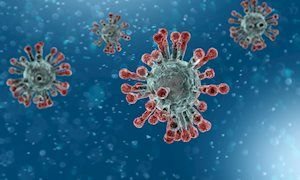
In most people, a SARS-CoV-2 infection causes mild respiratory symptoms. But in 10 to 15 percent of those infected, it leads to pneumonia and ARDS (acute respiratory distress syndrome), where inflammation disrupts the usual immune response, causing an almost unstoppable ‘hyper-inflammation’. To date, no comprehensive hypothesis has explained exactly how this life-threatening inflammatory process proceeds.
Image of biomarkers
To gain more insight into that process, researchers from Radboud university medical center and their Dutch colleagues looked at the blood of COVID-19 patients to identify substances that play an essential role in immunological and inflammatory processes. The presence or absence of such substances (biomarkers) can provide a good indication of what is happening in the body. They therefore analyzed biomarkers from 119 patients, 38 of whom were in the ICU and 89 in regular wards.Corona patients in the ICU
“For example, we looked at various interleukins, which we know play an important role in those processes,” says internist Frank van de Veerdonk. “But if you want to detect unknown processes, you also have to search without bias for other substances that may be important. That is why we searched very broadly with a technique called targeted proteomics and analyzed all that data using a systems biology approach. This provided an excellent overview of the immunological and inflammatory processes that take place in the patients. The important question was then: do we see differences in biomarkers between the patients in the regular wards and the seriously ill patients in the ICU?”Pathogenic mechanism
The answer was ‘yes’. For example, in IC patients, the researchers found increased concentrations of interleukin 6 (IL-6), various chemokines, hepatocyte growth factor and various components of the complement system. In contrast, the concentrations of stem cell factor, DPP4 and protein C inhibitor were substantially lower in ICU patients. These data point to an overarching pathogenic mechanism that appears in almost all critically ill COVID-19 patients.Three pathways to disease development
In any case, the researchers see three clear pathways to the development of the disease (see illustration). The infection pathway, in which the SARS-CoV-19 virus infects more and more cells, has been previously described. The other two pathways are less well known. The observed decrease in stem cell factor (SCF) is directly related to a lower production of white blood cells. It is known that a shortage of white blood cells increases mortality risk.Source: MedRxiv
Leaking blood vessels
The third pathway is directly related to the phenomenon that many COVID-19 patients describe as acute breathing difficulty due to the sudden ‘filling of the lungs’. Researchers at Radboud university medical center previously hypothesized that the local disappearance of ACE2 (angiotensin-converting enzyme 2) on lung cells due to the massive virus infection would make the blood vessels leak. They published that hypothesis in the article Kallikrein-kinin blockade in patients with COVID-19 to prevent acute respiratory distress syndrome in the journal eLife
Kinins
The idea is that ACE2 plays a role not only in regulating blood pressure throughout the body, but also in regulating the amount of kinins. Without that regulation, kinins are given free rein and cause leakage in the small blood vessels in the lungs. “The decrease in biomarkers such as DPP4 and protein C inhibitor that we found in our study supports our hypothesis,” said internist Mihai Netea. “Both substances play a role in the kallikrein-kinin system (KKS), which makes it plausible that this pathway also plays an important role in the disease process. Our findings make it possible to accelerate the development of new treatments for this group of COVID-19 patients.”
-
MedRxiv: A systems approach to inflammation identifies therapeutic targets in SARS-CoV-2 infection - Frank L. van de Veerdonk, Nico A.F. Janssen, Inge Grondman, Aline H. de Nooijer, Valerie A.C.M. Koeken, Vasiliki Matzaraki, Collins K. Boahen, Vinod Kumar, Matthijs Kox, Prof Hans J.P.M. Koenen, Ruben L. Smeets, Prof Irma Joosten, Roger J.M. Brüggemann, Ilse J.E. Kouijzer, Prof Hans G. van der Hoeven, Jeroen A. Schouten, Tim Frenzel, Monique Reijers, Wouter Hoefsloot, Anton S.M. Dofferhoff, Angèle P.M. Kerckhoffs, Marc J.T. Blaauw, Karin Veerman, Coen Maas, Arjan H.Related news items

Antibodies are sustained in nasal fluid after mild corona infection
27 September 2021 Testing through nasal fluids is easier than through blood go to page
Less inflammation with a traditional Tanzanian diet than with a Western diet
18 February 2021 Study shows differences between western and traditional diet. go to page
Trained immunity: a tool for reducing susceptibility to and the severity of SARS-CoV-2 infection
17 February 2021 In a review in Cell Mihai Netea, Frank van de Veerdonk, Reinout van Crevel and Jorge Dominguez Andres propose that induction of trained immunity by whole-microorganism vaccines may represent an important tool for reducing susceptibility to and severity of SARS-CoV-2. go to page
ZonMw grants to study optimal use of COVID-19 vaccines in patients with impaired immune systems
3 February 2021 How do people with reduced immunity, especially kidney patients, react to a COVID-19 vaccination? And how can patients with peripheral arterial disease be helped by DNA testing? Our researchers received grants from ZonMw to make these studies possible. go to page

